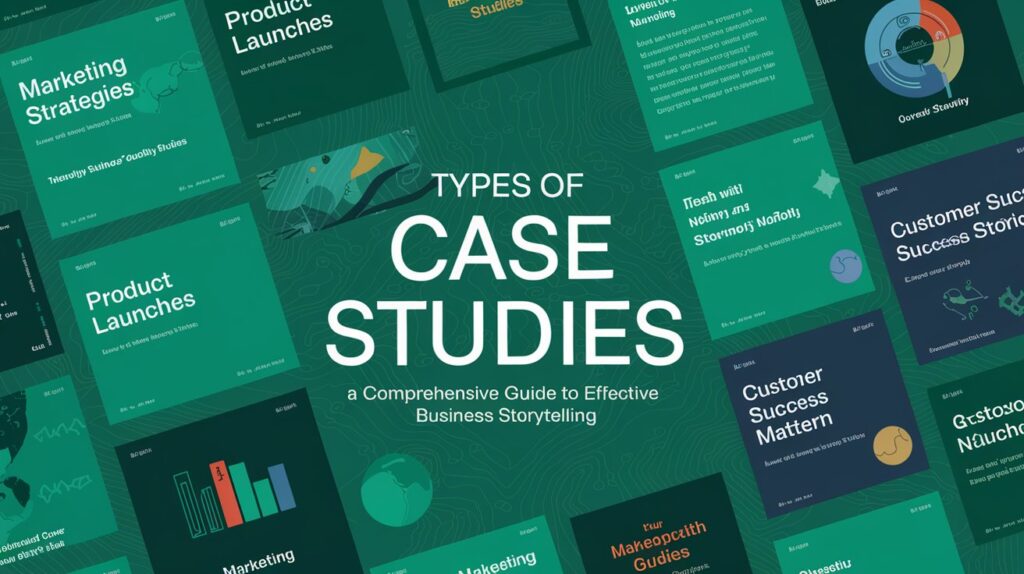In today’s competitive business environment, case studies have become a cornerstone of effective storytelling. Businesses use case studies to illustrate success, build credibility, and connect with potential clients. Understanding the types of case studies can help you craft powerful narratives that resonate with your audience.
Whether you aim to showcase client success, explain technical solutions, or highlight research findings, each type of case study serves a unique purpose. Let’s dive into the diverse world of case studies and explore their impact on business storytelling.

What Are Case Studies?
Case studies are in-depth analyses of specific instances, events, or projects that provide insights into a particular subject. They are an essential marketing and educational tool used across industries to:
- Demonstrate expertise and problem-solving capabilities.
- Showcase successful client collaborations.
- Build trust with potential clients and stakeholders.
By leveraging different types of case studies, businesses can tailor their stories to meet specific audience needs.
Why Are Case Studies Important for Businesses?
Case studies are more than just storytelling; they are a strategic tool for growth. Here are a few reasons why businesses rely on case studies:
- Credibility Boost: Case studies provide real-world examples of your capabilities, adding credibility to your claims.
- Audience Engagement: Engaging narratives captivate readers and help them relate to your brand.
- Decision-Making Support: Prospective clients use case studies to assess your suitability for their needs.
Understanding the types of case studies ensures that you can effectively target your audience and address their pain points.
Types of Case Studies
1. Client Success Case Studies
Client success case studies are among the most popular types of case studies. They highlight how a business has helped a client achieve specific goals. These studies focus on:
- The client’s challenges.
- The solutions provided.
- Tangible results achieved.
Example: A digital marketing agency showcases how they increased a client’s website traffic by 200% in six months.
2. Product or Service Case Studies
These case studies focus on a specific product or service, demonstrating its features, benefits, and real-world applications. They often include technical details and practical examples.
Example: A SaaS company creates a case study showcasing how their software streamlined operations for a manufacturing company.
3. Industry-Specific Case Studies
Industry-specific case studies target a particular sector, such as healthcare, finance, or retail. They address unique challenges and solutions relevant to that industry.
Example: A financial consulting firm highlights how their strategies helped a retail company improve cash flow.
4. Research-Based Case Studies
Research-based case studies are used to present findings from detailed investigations. These are common in academic and scientific fields but are also used in businesses to validate claims.
Example: A renewable energy company publishes a case study detailing the efficiency improvements from their new technology.
5. Exploratory Case Studies
Exploratory case studies are used to investigate a problem and identify potential solutions. They are often the starting point for deeper research or development projects.
Example: A startup conducts a case study on customer behavior to develop a new app feature.
How to Choose the Right Type of Case Study
Selecting the right type of case study depends on your objectives and target audience. Here are a few considerations:
- Objective: Are you aiming to build trust, educate your audience, or promote a product?
- Audience: What are their pain points and preferences?
- Resources: Do you have access to the data or clients needed to create a compelling story?
By aligning your goals with the appropriate types of case studies, you can maximize their impact.
Best Practices for Creating Effective Case Studies
- Choose Relevant Topics: Select subjects that resonate with your target audience.
- Use Data and Metrics: Incorporate quantifiable results to substantiate your claims.
- Include Visuals: Charts, graphs, and images make case studies more engaging.
- Keep It Clear and Concise: Avoid jargon and focus on delivering value.
- End with a Call-to-Action: Guide readers to the next step, such as contacting your team or visiting your website.
How Case Studies Drive Business Success
When executed effectively, case studies can:
- Enhance Brand Reputation: Showcase your expertise and reliability.
- Boost Conversions: Persuasive storytelling convinces potential clients to take action.
- Support Marketing Efforts: Versatile and reusable, case studies enhance blogs, social media, and presentations.
Investing in the right types of case studies ensures that your business remains relatable and impactful.
Conclusion
Case studies are a powerful tool for effective business storytelling. By understanding the types of case studies, you can craft narratives that resonate with your audience and achieve your goals. Whether it’s showcasing client success, exploring industry-specific challenges, or validating research, each type plays a vital role in business growth.
Ready to create impactful case studies for your brand? Partner with experts who understand the nuances of storytelling and audience engagement. Explore more at Pen2Paper.
